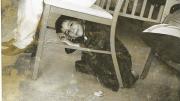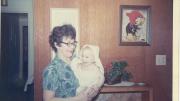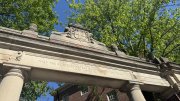I am a converted pediatrician. A product of Harvard Medical School in the 1950s, trained almost entirely in adult medicine, I began my career as a hematologist focused on disorders of the blood in adults. Fortunately my base was the then Peter Bent Brigham Hospital, an excellent but entirely outmoded facility in close proximity to the then equally Dickensian Children’s Hospital. Though its facilities were pathetic, Children’s had a brilliant faculty, among them Louis K. Diamond, one of the fathers of pediatric hematology. Diamond showed me the way. He invited me to see his most complex patients, and I became utterly fascinated by them. When I was invited to join his division, become a pediatrician, and ultimately direct it, I jumped at the chance.
I had come to realize that treatment of ill children may allow a physician to have decades of experience with individual patients throughout their growth and development, and to take advantage of new therapies as they slowly emerge from research laboratories and pharmaceutical companies. Though the care of very ill children, particularly children with serious blood diseases, can be very challenging, when new therapeutic approaches enable former patients to enjoy productive lives, the reward is huge, as I was reminded this past May.
A trip to Clarkson University, in Potsdam, New York, offered an opportunity to reconnect with two brothers whom I had seen with Dr. Diamond in the mid 1960s, and who still lived in nearby Saranac Lake.
Michael, now in his fifties, was three years old when I first examined him. He had been afflicted with severe anemia since birth and required regular red blood cell transfusions. It was readily apparent that his own erythrocytes were being rapidly destroyed, and his spleen, an abdominal organ that removes old or damaged red cells, was greatly enlarged. It therefore stood to reason that removal of the spleen might alleviate the anemia.
The operation was performed skillfully, but with mixed results. The need for transfusions was greatly reduced, but the red cells were still rapidly destroyed, and the boy remained anemic. As my colleagues and I pondered the case, Michael’s mother bore a second boy, Joseph, with the same problem.
After a great deal of laboratory work, a survey of all members of the family, and searches of the literature, we determined that both boys had inherited a copy of an altered gene from each parent. The tiny defect or mutation, present in both copies of the gene in these boys, seriously damaged the function of an enzyme protein, pyruvate kinase, in their red blood cells. That enzyme protein, we soon learned, is essential to maintain the life span of all human red cells. The boys were only the second set of such patients to be so identified worldwide.
Michael and Joseph returned intermittently to Boston for follow-up studies until their early teens, when their care was transferred permanently to local physicians. But the challenge of their rare inherited anemia always preoccupied me. How, I wondered, could we find a way to reactivate their genetically defective enzyme and cure their anemia? I was to gain a possible answer to that question almost a half-century later.
Before my trip to Potsdam, I e-mailed Michael and Joseph and asked them to meet me in Saranac Lake. Michael was there with his 90-year-old father, whom I had not seen since 1963. Michael had established a career as a technician in medical, food service, and computer laboratories; he has the background to understand the research related to his disease. We had a spectacular reunion during which I told them that a biotech company has just developed a drug that can reactivate the defective protein. That firm is now testing Michael’s and Joseph’s cells to see if the drug will reactivate their weakened enzyme. If that happens, my two former patients and others like them around the world may recover from their chronic anemia.
I continued on to Potsdam, where serendipity brought me together with Mark, a 52-year-old whom I had last seen at Children’s in 1966, when he was only a six-year-old, growing up chronically ill in a Boston suburb. Today he is a communications engineer—he invented the interface between copper wire phones and broadband cable that allows voice messages to travel on the Internet, and is working to bring broadband to the rural areas of St. Lawrence County, New York—but then he suffered from repeated bouts of infection caused by ordinary skin and gut bacteria and fungi that cohabit harmlessly in normal people. He had developed one deep abscess after another.
Tests of Mark’s immune system appeared normal, but Bob Baehner, a trainee in pediatric blood diseases, and I discovered something very unusual about his granulocytes. These are the most numerous white cells in the blood, and they ingest and destroy germs—but we found that a key enzyme, responsible for generating antimicrobial hydrogen peroxide, was defective in them. We developed a quick color test to measure the enzyme activity and soon found several other patients. Years later, Stuart Orkin, another faculty member in Children’s pediatric hematology program, cloned and identified the gene complex. Since then, much more has been learned about the several different mutations that can cause chronic granulomatous disease, or CGD. Mark remains very susceptible to infections, particularly of his lungs, but he and his physicians have developed stopgap treatments that temporarily quell them.
Meanwhile intensive work is under way to develop curative gene therapy for CGD. A normal gene can be inserted into the bone-marrow stem cells of patients to replace the function of their defective CGD gene. The stem cells carrying the correct genes give rise to normal functioning granulocytes that can eat and kill germs by dousing them with peroxide. When that technique is fully mastered, Mark and patients like him will finally gain relief. Michael and Joseph could benefit as well, because we could quite possibly insert a normal pyruvate kinase gene into their bone-marrow stem cells and cure their anemia.
Gene therapy has a long, complex history. It sounds straightforward and has been successful in a few patients worldwide, but there are high risks of failure and of ugly complications as serious as leukemia. Nevertheless, current technology suggests there may be safe and effective approaches on the horizon. My three middle-aged patients would be worthy beneficiaries.
They are examples of the excitement and satisfaction to be derived from a career devoted to overcoming difficult illnesses in children. Of course it is a gamble: the physician may not have the proper tools at the first encounter, but if the patient is a child, biomedical science may in time develop those tools. All the physician needs to do is keep trying—and live long enough to see the victory. I think I see victory around the corner for Michael, Joseph, and Mark.











